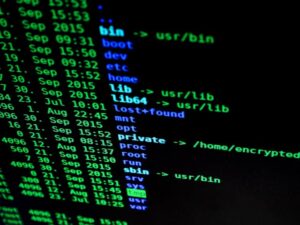In today’s digitally-driven world, our online security is constantly under threat. Hackers are becoming increasingly sophisticated, finding new ways to breach our systems and compromise our personal information. Understanding how we get attacked by hackers is vital in order to protect ourselves and our digital assets.
In this article, we will explore the common techniques hackers use to gain unauthorized access to our computers, networks, and devices. From phishing emails and social engineering to malware and ransomware attacks, we will delve into the tactics these cybercriminals employ to exploit vulnerabilities and deceive unsuspecting victims.

By understanding the methods used by hackers, we can take proactive measures to safeguard our digital lives. We’ll discuss the importance of strong passwords, regular software updates, and the use of multi-factor authentication. Additionally, we’ll provide practical tips on how to identify and avoid suspicious links and attachments, as well as how to recognize signs of a potential breach.
Don’t wait until it’s too late. Join us as we uncover the secrets of how hackers infiltrate our digital lives, and learn how to protect yourself against these ever-evolving threats.
Types of Hacking Attacks: How We Get Attacked by Hackers
Hackers employ various techniques to gain unauthorized access to our systems and compromise our security. Understanding the different types of hacking attacks can help us better protect ourselves. One common type is the phishing attack. Phishing attacks typically involve emails or messages that appear to be from legitimate sources, but are actually designed to trick users into revealing sensitive information or downloading malicious software. These attacks often rely on psychological manipulation and social engineering to deceive victims.
Another type of hacking attack is the malware attack. Malware, short for malicious software, refers to any program or code that is designed to harm or exploit a computer or network. This can include viruses, worms, trojans, and ransomware. Malware attacks can be devastating, causing data loss, financial loss, and even identity theft.
Additionally, hackers may use brute force attacks to gain unauthorized access to systems. Brute force attacks involve systematically attempting all possible combinations of passwords until the correct one is found. This method can be time-consuming, but it can be effective against weak or easily guessable passwords.
Common Targets for Hacking Attacks
Hackers can target a wide range of individuals and organizations. One common target is individuals who have valuable personal information, such as bank account details or social security numbers. By gaining access to this information, hackers can commit identity theft or financial fraud.
Businesses are also prime targets for hacking attacks. Hackers may target businesses in order to gain access to sensitive customer data, trade secrets, or financial information. The impact of a successful hacking attack on a business can be severe, leading to financial loss, reputational damage, and legal consequences.
Government institutions and critical infrastructure are also vulnerable to hacking attacks. These attacks can disrupt essential services, compromise national security, and cause widespread chaos.
Impact of Hacking Attacks on Businesses and Individuals
The impact of hacking attacks can be devastating for both businesses and individuals. For businesses, a successful hacking attack can result in significant financial loss. This can occur through theft of funds, loss of intellectual property, or the cost of remediation and recovery. The reputational damage caused by a hacking attack can also have long-lasting consequences, leading to a loss of trust from customers and partners.
For individuals, the impact of a hacking attack can be equally damaging. Personal information, such as social security numbers, credit card details, and passwords, can be stolen and used for identity theft or financial fraud. This can result in financial loss, damage to credit scores, and emotional distress. Additionally, the loss of personal data can have long-term consequences, potentially impacting future employment prospects and personal relationships.
Understanding the Motives Behind Hacking Attacks
To effectively protect ourselves against hacking attacks, it’s important to understand the motives behind these cybercrimes. While some hackers are motivated by financial gain, others may be driven by political or ideological reasons. Hacktivism, for example, refers to hacking activities carried out to promote a political or social cause. These hackers may target government institutions, corporations, or individuals they perceive as enemies or opponents.
Other hackers may engage in cyber espionage, seeking to gather intelligence and gain a competitive advantage. Nation-states, in particular, may carry out hacking attacks to gather sensitive information, disrupt rival nations, or gain a strategic advantage.
Methods Used by Hackers to Gain Unauthorized Access
Hackers employ a variety of methods to gain unauthorized access to our systems and networks. One common technique is social engineering. Social engineering involves manipulating individuals into revealing sensitive information or granting access to secure systems. This can be done through techniques such as impersonation, deception, or psychological manipulation.
Another method used by hackers is the use of malware. Malware can be delivered through various means, including email attachments, malicious websites, or compromised software. Once installed on a system, malware can give hackers full control over the device, allowing them to steal information, monitor activities, or launch further attacks.
Additionally, hackers may exploit vulnerabilities in software or operating systems. This can involve exploiting known security flaws or zero-day vulnerabilities, which are previously unknown vulnerabilities that have not yet been patched by software developers. By exploiting these vulnerabilities, hackers can gain unauthorized access to systems and networks.

Protecting Yourself from Hacking Attacks – Best Practices and Preventive Measures
Protecting yourself from hacking attacks is crucial in today’s digital landscape. There are several best practices and preventive measures you can take to enhance your online security.
First and foremost, it’s important to use strong and unique passwords for all your accounts. Avoid using common passwords or easily guessable information such as your name or birthdate. Instead, use a combination of uppercase and lowercase letters, numbers, and special characters. Consider using a password manager to generate and securely store your passwords.
Regularly updating your software and operating systems is also essential. Software updates often include security patches that fix vulnerabilities and protect against known threats. Enable automatic updates whenever possible to ensure you stay protected against the latest threats.
Multi-factor authentication (MFA) is another effective measure to protect your accounts. MFA adds an extra layer of security by requiring additional verification, such as a fingerprint scan or a unique code sent to your mobile device, in addition to your password.
When it comes to email security, be cautious of suspicious links and attachments. Avoid clicking on links or downloading attachments from unfamiliar or suspicious sources. Hover over links to check the URL before clicking, and be wary of unexpected emails asking for personal or financial information.
Recognizing Signs of a Hacking Attack
Recognizing the signs of a hacking attack is crucial in order to take immediate action and minimize the damage. Some common signs include:
- Unusual account activity: If you notice unfamiliar or suspicious activity on your accounts, such as unauthorized transactions or changes to your settings, it may be a sign of a hacking attack.
- Slow or unresponsive systems: If your computer or device suddenly becomes slow or unresponsive, it could indicate the presence of malware or a hacking attempt.
- Unexpected pop-ups or error messages: Pop-ups or error messages that appear out of nowhere could be a sign of malware or a hacking attempt.
- Unusual network traffic: If you notice a significant increase in network activity or data usage, it could be a sign that your system has been compromised.
If you suspect that you have been hacked, it’s important to take immediate action. Disconnect from the internet to prevent further damage, and scan your system for malware using reputable antivirus software. Change your passwords for all your accounts, and monitor your accounts for any suspicious activity. If necessary, contact your bank, credit card companies, or other relevant institutions to report the incident and take appropriate action.
Steps to Take if You Have Been Hacked
If you have been hacked, it’s important to follow a step-by-step process to minimize the damage and protect yourself:
- Disconnect from the internet: Immediately disconnect from the internet to prevent further unauthorized access to your system.
- Scan for malware: Use reputable antivirus software to scan your system for malware and remove any found infections.
- Change passwords: Change the passwords for all your accounts, especially those that may have been compromised. Use strong and unique passwords for each account.
- Enable multi-factor authentication (MFA): Enable MFA for all your accounts that support it. This adds an extra layer of security by requiring additional verification.
- Monitor your accounts: Regularly monitor your accounts for any suspicious activity. Report any unauthorized transactions or changes to your account settings.
- Update software and operating systems: Ensure that all your software and operating systems are up to date with the latest security patches.
- Educate yourself and others: Learn from the experience and educate yourself about online security best practices. Share your knowledge with friends, family, and colleagues to help them protect themselves as well.
Conclusion and Importance of Cybersecurity
In conclusion, understanding how we get attacked by hackers is crucial in order to protect ourselves and our digital lives. Hackers employ various techniques, such as phishing, malware attacks, and social engineering, to gain unauthorized access to our systems and compromise our security. By implementing best practices and preventive measures, such as using strong passwords, regularly updating software, and being cautious of suspicious links and attachments, we can enhance our online security and minimize the risk of falling victim to hacking attacks.
Recognizing the signs of a hacking attack and taking immediate action is equally important. Disconnecting from the internet, scanning for malware, changing passwords, and monitoring accounts are crucial steps to take if you suspect that you have been hacked.
Ultimately, cybersecurity is a shared responsibility. By staying informed, practicing good online habits, and educating others, we can collectively create a safer digital environment for everyone. Don’t wait until it’s too late – take action now to protect yourself against the ever-evolving threats posed by hackers.